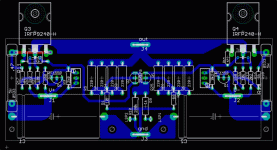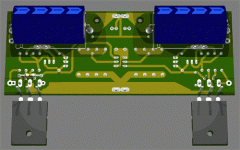half power
Another solution would be to go for another jfet input current feedback design like the Jean Hiraga class A Le Monstre...which uses a lower voltage rail supply...😀
udailey said:THAT is a neat idea 🙂 Nice thinking and good solution to his problem.
Uriah
Another solution would be to go for another jfet input current feedback design like the Jean Hiraga class A Le Monstre...which uses a lower voltage rail supply...😀
Re: Re: Re: Half Power
Isn't it enough enlightened from Master himself ?
fab said:
Can you please enlight me?
Isn't it enough enlightened from Master himself ?
Re: Re: Re: Re: Half Power
Easy one...
😀
What do YOU think?😉
Is it better to reduce the bias or the rail voltage to be closer to same linearity of the original design...?😀
estman said:
Isn't it enough enlightened from Master himself ?
Easy one...
😀
What do YOU think?😉
Is it better to reduce the bias or the rail voltage to be closer to same linearity of the original design...?😀
I didn't see an answer to my question so here goes again...
Should the PCB have decoupling caps for the power rails?
I do not see them in the schematic, nor on pictures of the F5.
...my board so far, could not go for NP's long, thin boards as my sinks are 20cm width, but I can get it in custom heights, I think about 35 to 40cm high should be high enough.
Should the PCB have decoupling caps for the power rails?
I do not see them in the schematic, nor on pictures of the F5.
...my board so far, could not go for NP's long, thin boards as my sinks are 20cm width, but I can get it in custom heights, I think about 35 to 40cm high should be high enough.
Attachments
Nordic said:Should the PCB have decoupling caps for the power rails?
I do not see them in the schematic, nor on pictures of the F5.
Not a bad idea, it does improve the square wave if your PS doesn't
have a low enough impedance up a 1 MHz or so.
2sk170, and I'll have to get its complementary off e-bay at the cost of an arm a leg and a toenail.
udailey said:Nice catch estman. Still nice looking layout and easy fix.
Uriah
Yes, it is nice. I would make star for inp GND and then join it to the C1,J3,C2.
3 F5, 1 PS
Hello,
I'm planning to build 3 F5 for tri-amping, I have the parts for the amps (thx Jackinnj) and the heatsink.
Now for the PS, I would like to have just one feeding the 3 amps.
The design would be the one in attachment (from PSU2).
For the coil, the SuperQ 2mH, 14 gauge from Erse @ Zalytron and the transformer a 600Va from Antek
I've simulated the full load as the two secondary were in //.
Is it nonsense?
Thx,
Arnaud
Hello,
I'm planning to build 3 F5 for tri-amping, I have the parts for the amps (thx Jackinnj) and the heatsink.
Now for the PS, I would like to have just one feeding the 3 amps.
The design would be the one in attachment (from PSU2).
For the coil, the SuperQ 2mH, 14 gauge from Erse @ Zalytron and the transformer a 600Va from Antek
I've simulated the full load as the two secondary were in //.
Is it nonsense?
Thx,
Arnaud
An externally hosted image should be here but it was not working when we last tested it.
EUVL said:After delivering all the Fairchild FETs for the Group Buy, I finally got down to do some measurement of the FETs, and just finished measuring one amp tonight.
Apart from very different Vgs btw P and N devices, the transcoductances also differ by a factor of 1.7 at 2A bias. In comparison to the Toshibas, they are anything but complementary. See attached pdf.
But good. The bias was set at 1.5A per FET at the start, and went up to 2.3A in the end -- quite a bit worst than the Toshiba (1.75A -> 2A) on exactly the same heatsink, etc. Furthermore, the P and the N devices drifted differently with temperature, resulting in an DC offset in the end of something like 25mV. Not that it is an issue, as I am using the balanced version anyway, so they cancel out on both sides.
The frequency response is similar, with a very slight rise of 0.5dB at 600kHz. Probably still curable by fiddling with gate resistor values, etc.
More to follow. Bed time now. 😱
Patrick
okay, time to end the speculations and ask Papa 🙂
Mr. Pass:
Can you comment on whether or not the Fairchild FQA19N20C / FQA12P20 devices are suitable for the F4 amplifier (stock, unmodified schematic), given the Patrick's findings? Is there a need to compensate the top and bottom of the schematic for the differing transconductance? Is there any benefit in using the Fairchld FQA19N20C / FQA12P20 over the IRF (Vishay) IRFP9240 / IRFP240 in the F4 schematic?
okay, there I've said it. 🙂
luvdunhill said:
okay, time to end the speculations and ask Papa 🙂
Mr. Pass:
Can you comment on whether or not the Fairchild FQA19N20C / FQA12P20 devices are suitable for the F4 amplifier (stock, unmodified schematic), given the Patrick's findings? Is there a need to compensate the top and bottom of the schematic for the differing transconductance? Is there any benefit in using the Fairchld FQA19N20C / FQA12P20 over the IRF (Vishay) IRFP9240 / IRFP240 in the F4 schematic?
okay, there I've said it. 🙂
Papa already sez few words about that ;
this thread have just 1581 posts , so it's pretty easy to find it 😉
luvdunhill said:Can you comment on whether or not the Fairchild FQA19N20C / FQA12P20 devices are suitable for the F4 amplifier (stock, unmodified schematic), given the Patrick's findings? Is there a need to compensate the top and bottom of the schematic for the differing transconductance? Is there any benefit in using the Fairchld FQA19N20C / FQA12P20 over the IRF (Vishay) IRFP9240 / IRFP240 in the F4 schematic?
That's what I use. If you have a distortion analyzer you can put a
little better trim on the 1 KHz, 1 Watt numbers, but I find that most
channels do not need this. Generally, I play with the resistor values if
the THD exceeds .005% or so at this level.
The IRFP9240 has an issue with higher distortion than the Fairchild
or Harris parts. You can use them anyway and get what many
would consider acceptable performance. If you are using it as a
bass amplifier there is no difference to speak of, and there is no
problem with the IRFP240 and other N channel vertical parts that I
have seen.
- Home
- Amplifiers
- Pass Labs
- F5 power amplifier



